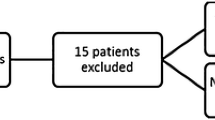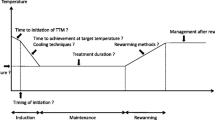Abstract
Purpose
Few outcome data are available about temperature management after intraoperative cardiac arrest (IOCA). We describe targeted temperature management (TTM) (32–34 °C) modalities, adverse events, and association with 1-year functional outcome in patients with IOCA.
Methods
Patients admitted to 11 ICUs after IOCA in 2008–2013 were studied retrospectively. The main outcome measure was 1-year functional outcome.
Results
Of the 101 patients [35 women and 66 men; median age, 62 years (interquartile range, 42–72)], 68 (67.3%) were ASA PS I to III and 57 (56.4%) had emergent surgery. First recorded rhythms were asystole in 44 (43.6%) patients, pulseless electrical activity in 36 (35.6%), and ventricular fibrillation/tachycardia in 20 (19.8%). Median times from collapse to cardiopulmonary resuscitation and return of spontaneous circulation (ROSC) were 0 min (0–0) and 10 min (4–20), respectively. The 30 (29.7%) patients who received TTM had an increased risk of infection (P = 0.005) but not of arrhythmia, bleeding, or metabolic/electrolyte disorders. By multivariate analysis, one or more defibrillation before ROSC was positively associated with a favorable functional outcome at 1-year (OR 3.06, 95% CI 1.05–8.95, P = 0.04) and emergency surgery was negatively associated with 1-year favorable functional outcome (OR 0.36; 95% CI 0.14–0.95, P = 0.038). TTM use was not independently associated with 1-year favorable outcome (OR 0.82; 95% CI 0.27–2.46, P = 0.72).
Conclusions
TTM was used in less than one-third of patients after IOCA. TTM was associated with infection but not with bleeding or coronary events in this setting. TTM did not independently predict 1-year favorable functional outcome after IOCA in this study.



Similar content being viewed by others
Notes
http://www.R-project.org. Accessed 14 September 2016.
References
Nunnally ME, O’Connor MF, Kordylewski H, Westlake B, Dutton RP (2015) The incidence and risk factors for perioperative cardiac arrest observed in the national anesthesia clinical outcomes registry. Anesth Analg 120:364–370
Peberdy MA, Ornato JP, Larkin GL, Braithwaite RS, Kashner TM, Carey SM, Meaney PA, Cen L, Nadkarni VM, Praestgaard AH, Berg RA (2008) Survival from in-hospital cardiac arrest during nights and weekends. JAMA 299:785–792
Sprung J, Warner ME, Contreras MG, Schroeder DR, Beighley CM, Wilson GA, Warner DO (2003) Predictors of survival following cardiac arrest in patients undergoing noncardiac surgery: a study of 518,294 patients at a tertiary referral center. Anesthesiology 99:259–269
Kheterpal S, O’Reilly M, Englesbe MJ, Rosenberg AL, Shanks AM, Zhang L, Rothman ED, Campbell DA, Tremper KK (2009) Preoperative and intraoperative predictors of cardiac adverse events after general, vascular, and urological surgery. Anesthesiology 110:58–66
Goswami S, Brady JE, Jordan DA, Li G (2012) Intraoperative cardiac arrests in adults undergoing noncardiac surgery: incidence, risk factors, and survival outcome. Anesthesiology 117:1018–1026
Kawashima Y, Takahashi S, Suzuki M, Morita K, Irita K, Iwao Y, Seo N, Tsuzaki K, Dohi S, Kobayashi T, Goto Y, Suzuki G, Fujii A, Suzuki H, Yokoyama K, Kugimiya T (2003) Anesthesia-related mortality and morbidity over a 5-year period in 2,363,038 patients in Japan. Acta Anaesthesiol Scand 47:809–817
Ramachandran SK, Mhyre J, Kheterpal S, Christensen RE, Tallman K, Morris M, Chan PS, American Heart Association’s Get With The Guidelines-Resuscitation Investigators (2013) Predictors of survival from perioperative cardiopulmonary arrests: a retrospective analysis of 2524 events from the Get With The Guidelines-Resuscitation registry. Anesthesiology 119:1322–1339
Constant AL, Montlahuc C, Grimaldi D, Pichon N, Mongardon N, Bordenave L, Soummer A, Sauneuf B, Ricome S, Misset B, Schnell D, Dubuisson E, Brunet J, Lasocki S, Cronier P, Bouhemad B, Loriferne JF, Begot E, Vandenbunder B, Dhonneur G, Bedos JP, Jullien P, Resche-Rigon M, Legriel S (2014) Predictors of functional outcome after intraoperative cardiac arrest. Anesthesiology 121:482–491
The Hypothermia After Cardiac Arrest Study Group (2002) Mild therapeutic hypothermia to improve the neurologic outcome after cardiac arrest. N Engl J Med 346:549–556
Bernard SA, Gray TW, Buist MD, Jones BM, Silvester W, Gutteridge G, Smith K (2002) Treatment of comatose survivors of out-of-hospital cardiac arrest with induced hypothermia. N Engl J Med 346:557–563
Cariou A, Nolan JP, Sunde K (2015) Ten strategies to increase survival of cardiac arrest patients. Intensive Care Med 41:1820–1823
Nielsen N, Wetterslev J, Cronberg T, Erlinge D, Gasche Y, Hassager C, Horn J, Hovdenes J, Kjaergaard J, Kuiper M, Pellis T, Stammet P, Wanscher M, Wise MP, Aneman A, Al-Subaie N, Boesgaard S, Bro-Jeppesen J, Brunetti I, Bugge JF, Hingston CD, Juffermans NP, Koopmans M, Kober L, Langorgen J, Lilja G, Moller JE, Rundgren M, Rylander C, Smid O, Werer C, Winkel P, Friberg H, TTM Trial Investigators (2013) Targeted temperature management at 33°C versus 36°C after cardiac arrest. N Engl J Med 369:2197–2206
Hazinski MF, Nolan JP, Aickin R, Bhanji F, Billi JE, Callaway CW, Castren M, de Caen AR, Ferrer JM, Finn JC, Gent LM, Griffin RE, Iverson S, Lang E, Lim SH, Maconochie IK, Montgomery WH, Morley PT, Nadkarni VM, Neumar RW, Nikolaou NI, Perkins GD, Perlman JM, Singletary EM, Soar J, Travers AH, Welsford M, Wyllie J, Zideman DA (2015) Part 1: executive summary: 2015 international consensus on cardiopulmonary resuscitation and emergency cardiovascular care science with treatment recommendations. Circulation 132:S2–S39
Nolan JP (2013) What’s new in the management of cardiac arrest? Intensive Care Med 39:1211–1213
Sessler DI (2001) Complications and treatment of mild hypothermia. Anesthesiology 95:531–543
Polderman KH (2009) Mechanisms of action, physiological effects, and complications of hypothermia. Crit Care Med 37:S186–S202
Keats AS (1978) The ASA classification of physical status–a recapitulation. Anesthesiology 49:233–236
An JX, Zhang LM, Sullivan EA, Guo QL, Williams JP (2011) Intraoperative cardiac arrest during anesthesia: a retrospective study of 218,274 anesthetics undergoing non-cardiac surgery. Chin Med J (Engl) 124:227–232
O’Connor C (1995) Intraoperative cardiac arrest. Anesthesiol Clin N Am 13:905–922
Gasparetto N, Scarpa D, Rossi S, Persona P, Martano L, Bianchin A, Castioni CA, Ori C, Iliceto S, Cacciavillani L (2014) Therapeutic hypothermia in Italian intensive care units after 2010 resuscitation guidelines: still a lot to do. Resuscitation 85:376–380
Storm C, Meyer T, Schroeder T, Wutzler A, Jorres A, Leithner C (2014) Use of target temperature management after cardiac arrest in Germany—a nationwide survey including 951 intensive care units. Resuscitation 85:1012–1017
Dumas F, Grimaldi D, Zuber B, Fichet J, Charpentier J, Pene F, Vivien B, Varenne O, Carli P, Jouven X, Empana JP, Cariou A (2011) Is hypothermia after cardiac arrest effective in both shockable and nonshockable patients? Insights from a large registry. Circulation 123:877–886
Weidman JL, Shook DC, Hilberath JN (2014) Cardiac resuscitation and coagulation. Anesthesiology 120:1009–1014
Stockmann H, Krannich A, Schroeder T, Storm C (2014) Therapeutic temperature management after cardiac arrest and the risk of bleeding: systematic review and meta-analysis. Resuscitation 85:1494–1503
Mongardon N, Perbet S, Lemiale V, Dumas F, Poupet H, Charpentier J, Pene F, Chiche JD, Mira JP, Cariou A (2011) Infectious complications in out-of-hospital cardiac arrest patients in the therapeutic hypothermia era. Crit Care Med 39:1359–1364
Perbet S, Mongardon N, Dumas F, Bruel C, Lemiale V, Mourvillier B, Carli P, Varenne O, Mira JP, Wolff M, Cariou A (2011) Early-onset pneumonia after cardiac arrest: characteristics, risk factors and influence on prognosis. Am J Respir Crit Care Med 184:1048–1054
Tsai MS, Chiang WC, Lee CC, Hsieh CC, Ko PC, Hsu CY, Su CP, Chen SY, Chang WT, Yuan A, Ma MH, Chen SC, Chen WJ (2005) Infections in the survivors of out-of-hospital cardiac arrest in the first 7 days. Intensive Care Med 31:621–626
Kakavas S, Mongardon N, Cariou A, Gulati A, Xanthos T (2015) Early-onset pneumonia after out-of-hospital cardiac arrest. J Infect 70:553–562
Dumas F, Bougouin W, Geri G, Lamhaut L, Bougle A, Daviaud F, Morichau-Beauchant T, Rosencher J, Marijon E, Carli P, Jouven X, Rea TD, Cariou A (2014) Is epinephrine during cardiac arrest associated with worse outcomes in resuscitated patients? J Am Coll Cardiol 64:2360–2367
Legriel S, Bruneel F, Sediri H, Hilly J, Abbosh N, Lagarrigue MH, Troche G, Guezennec P, Pico F, Bedos JP (2009) Early EEG monitoring for detecting postanoxic status epilepticus during therapeutic hypothermia: a pilot study. Neurocrit Care 11:338–344
Acknowledgements
We thank A. Wolfe MD (Issy-les-Moulineaux, France) for helping to prepare the manuscript.
Author contribution
SL, A-LC, and NM conceived, designed, and supervised the trial. SL, A-LC, DG, NM, NP, PC, SR, BS, JB, ED, AS, BV, EB, JL, BM, BB, DS, SM, SL, and BS collected the data; and SL coordinated the data collection. SL, CM, QM, and MRR analyzed and interpreted the data. CM, QM, and MRR performed the statistical analysis. SL, ALC, and NM wrote the first draft of the paper. All authors approved the final version of the manuscript.
Author information
Authors and Affiliations
Corresponding author
Ethics declarations
Funding
The study was supported by the French public funding agency Délégation à la Recherche Clinique et à l’Innovation (DRCI), Versailles, France.
Conflicts of interest
The authors declare no competing interests.
Additional information
Take-home message: TTM is used in less than one-third of patients after IOCA. Although 1-year functional outcome was lower in patients given TTM, TTM did not independently predict better functional outcome after IOCA in this study.
Electronic supplementary material
Below is the link to the electronic supplementary material.
134_2017_4709_MOESM1_ESM.tiff
ESM Table 1. Year of intraoperative cardiac arrest occurrence in patients managed with and without targeted temperature management – 2000 to 2013 (TIFF 16875 kb)
134_2017_4709_MOESM2_ESM.docx
ESM Table 2. Causes of intraoperative cardiac arrest surgery in the 101 survivors admitted to the intensive care unit (DOCX 38 kb)
Rights and permissions
About this article
Cite this article
Constant, AL., Mongardon, N., Morelot, Q. et al. Targeted temperature management after intraoperative cardiac arrest: a multicenter retrospective study. Intensive Care Med 43, 485–495 (2017). https://doi.org/10.1007/s00134-017-4709-0
Received:
Accepted:
Published:
Issue Date:
DOI: https://doi.org/10.1007/s00134-017-4709-0




